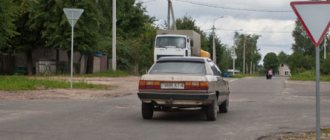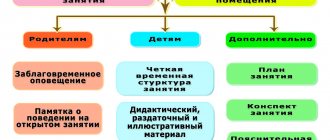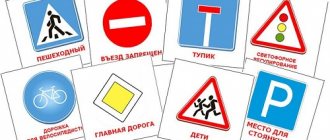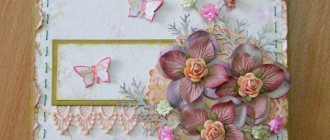MAGAZINE Preschooler.RF
Synopsis of a frontal speech therapy lesson for the senior group Topic: “Transport of our city” Motyzhenkova Irina Gerasimovna Teacher, MADOU kindergarten 334 City of Kazan Republic of Tatarstan Goals:1) correctional and educational: enrich and activate the vocabulary on the topic “Transport”; fix the names of the professions of people driving various types of transport, types of transport; activate adjectives in speech and consolidate the skill of agreeing adjectives with nouns; consolidate the ability to form plural nouns;
learn to compose sentences with the complex conjunction “to”; consolidate the assimilation of the verb “to go” with various prefixes; consolidate the ability to clearly and correctly answer questions posed; 2) correctional and developmental: develop skills in mastering the operations of generalization, classification, syllabic analysis skills; develop gross and fine motor skills; stimulate the development of visual and auditory attention, memory, logical thinking; 3) correctional and educational: to cultivate communication skills, respect for the work of the driver; cultivate a sensitive and attentive attitude towards each other;
Equipment: subject pictures depicting different types of transport; toy cars; magic box with double bottom; “magic train” with pockets for pictures and syllable diagrams; syllable patterns; truck traffic diagram poster; outline pictures on the topic “transport”; sweet marmalade cars (prizes);
Progress of the lesson:
ORGANIZING TIME
— The locomotive hummed and brought us pictures. (Recording of train whistle). — For each picture you need to select a diagram with the appropriate number of syllables. (Tractor, plane, train, bus, bicycle, ship).
INTRODUCTION TO THE TOPIC
- Look at the pictures and tell me what we will talk about. — That's right, about transport. - Guess the riddles. Draw the answers.
“We get up very early, because our job is to take everyone to work in the morning.” - That's right, this is the driver (driver).
The house on rails is right there. He'll kill everyone in five minutes. You sit down and don’t yawn, the (tram) is leaving.
What kind of bird does it sing, doesn’t build nests, carries people and cargo?
(Airplane.)
Name it. “One-many-affectionately.” Plane-planes-plane. Car - Tram - Bicycle - Steamboat - Helicopter - Ship - Steam locomotive -
DIDACTIC GAME “NAME YOUR PROFESSION”
(Pictures on the topic “transport” are displayed on a typesetting canvas).
- I will ask a question, and you will answer according to my example: Who drives the bus? — The bus is driven by an attentive driver.
—Who flies on an airplane? (A brave pilot flies on an airplane.) —Who controls the train? (The train is driven by a sharp-eyed driver). -Who flies on a rocket? (A skilled astronaut flies on a rocket.) —Who drives the tram? (The tram is driven by a diligent driver). —Who controls the ship? (The ship is steered by a brave captain). — Who rides a motorcycle? (A brave motorcyclist rides a motorcycle.) — Who flies a helicopter? (A brave pilot flies in a helicopter.) - Tell me in one word what it is? (Transport). — What types of transport do you know? (Water, air, land, underground).
- What kind of character are these people? (Conscientious, hardworking, diligent, polite, responsible, courageous, skillful, vigilant, disciplined).
TELLING A RIDDLE
Doesn't fly, doesn't buzz, the beetle runs down the street. And two brilliant lights burn in the beetle’s eyes. (Car).
- A big car, and a small one... (Car).
— We had a beautiful little car in our group, but trouble happened. An evil star warrior has taken to flying to us from the planet “Polomai.” He threatens to break all our toys. Look what he did to our truck. (Showing a flat model of a truck). He just crushed him. But you are skillful guys. Let's put the truck back together from the parts.
DIDACTICAL GAME “ASSEMBLY A TRUCK” (Children take turns taking car parts and putting them on the image of a truck).
— What parts does the truck have? (Cabin, engine, body, headlights, wheels, license plate, gas tank, seat, steering wheel, bumper).
(At the end of the game, one child lists all the parts of the truck.) — What a beautiful car it turned out to be, but it’s inconvenient to play with. Why? (It is flat, parts may fall apart).
- I have a magic box, maybe it will help us? Let's check. Let's put our truck in the box. Abra-kadabra, sim-nightingale, turn your flat car into a real truck! (The speech therapist takes out a toy car.)
“If the star warrior comes to us again, how will we deal with him?” (Make the truck invisible, make the truck big, bigger than the star warrior, shrink the star warrior to a very small size so he can't do anything).
ACQUISITION OF THE VERB “GO” WITH VARIOUS PRESETS
- Let's take our truck on a trip to the auto shop. (On the easel there is a poster diagram of the movement of a truck and a small toy truck).
We drove and drove, up to the hill... (arrived), (drove in, drove off) and further... (drove). We drove and drove and reached the pit... (we arrived), the Pit... (we drove around) and further... (we drove). We drove and drove, to the river... (we arrived), the Bridge... (we moved) and further... (we drove). From the bridge... (drove away) and further... (went on). We drove and drove, to the house... (arrived), In the yard... (drove), and here we are... (arrived).
DIDACTIC GAME “LOGN BY THE CONTOUR”
(Contours of transport superimposed on one another).
And now everyone went for a walk along the street. Many cars pass by us. You need to guess the car by its outline, circle it with your index finger and say what the car is for. (Drafting a sentence with the conjunction to).
PHYSICAL CLASS
We are driving, driving a car, (move the steering wheel) Press the pedal, (bend and stretch your leg) Turn on the gas, turn it off, (pull the “lever” towards you, away from you) We look intently into the distance. (palm to forehead) The wipers clean off the drops: Left, right - cleanliness. (arms in front of you, bend them at the elbows, open your palms, tilt your arms left, right) The wind ruffles your hair. (wiggle fingers) We are drivers anywhere! (thumbs up)
Now let’s start the engines: “Rrrr.” Go. We go, we go, we don’t rush straight to the car shop. (There are toy cars on display). An auto shop is a store that sells cars.
DRAWING WITH THREAD
(Sheets of velvet paper with drawn outlines of different cars and balls of thread for each child).
We stopped at the car shop. Your parents are probably waiting for you. Let's give them gifts. You need to lay out the machine along the contour with thread carefully and quickly.
RESULT
- The gifts are ready. Let's call our parents and tell them what you liked and what interesting things you learned. (Children press their fist to their ear. Children's answers). - And the star warrior gave you sweet cars and told me in confidence that he would never break toys again.
| Next > |
How people invented the wheel and transport Lykov
Natalya Shkitina
Lesson in the senior group. “How the wheel appeared” (cognitive development and manual labor)
Introduce children to the history of man's invention of the wheel; activate and expand knowledge of how a person uses the wheel. Develop observation skills, interest in creativity, and constructive skills. Strengthen the ability to determine the features of an object (shape, parts, size, material). Develop dialogical speech, the ability to clearly and consistently express your thoughts.
Vocabulary work: log, axle.
Material for the lesson:
For construction: matchboxes, wooden sticks, cardboard, thread, tape, scissors. Toy gnome, drawings of carts. For experimentation: details of a wooden construction set - bricks, cylinders.
Lesson plan:
Organizing time:
Emotional mood “Gather children in a circle”
The appearance of a fairy-tale hero - a gnome from the fairy tale "Snow White and the Seven Dwarfs"
Creating a situation of cognitive dispute:
Dwarf: “Guys, our Snow White is such a skill, she knows how to make delicious yogurt from wild berries and fresh milk. To bring her more berries, we need a cart. So I decided to design a cart, I even drew drawings. I would like to ask you for advice, which cart is better to make? (shows drawings of carts with triangular and square wheels. Children express their opinions)
Updating children's knowledge:
All objects that are around us were invented and made by man. Let's tell the gnome how a person uses the wheel, in what objects? (children remember and name objects that have wheels)
Guys, do you know how man invented the wheel itself, because it didn’t fall to earth from the moon? Let's sit down on the carpet and I'll tell you a story. A long time ago, people lived on earth; they had neither cars nor airplanes; they walked on their own feet. They decided to build themselves a dwelling made of stone. They found a large stone in the mountains, very heavy, but they didn’t know how to deliver it to the construction site. They pushed him this way and that, they lifted him, but they couldn’t carry him. Then, out of frustration, the man kicked a log that was lying nearby, and it rolled. The man looked at the log, at the stone, and exclaimed: “I came up with an idea!”
Experimental activities for children:
What do you think a man came up with to roll a heavy stone to a construction site? (experimenting with building material details)
Guys, can we help the gnomes, teach them how to make carts? To get into the fairy tale we need to go through a dark cave.
Dynamic game "Cave"
We are in the gnomes’ workshop (we sit on chairs around the table) Let’s see what is there (we name the objects, what shape they are, size, what material they are made of)
Statement and solution of the problem problem:
Can we make a cart out of them? How? How to make the wheels spin? What needs to be done to make it convenient to use the cart? Now you can make carts yourself, but first let’s stretch our fingers.
Construction: We go to the tables. While we were discussing how to construct a cart, the gnome drew a diagram of how to make it (we are discussing the sequence of work) Let's get to work.
Result: We are considering the work. Children record in speech: what new things have they learned, where will the new things be useful?
DIY pool. Summer is in full swing. And in the summer, children love to play with water. It is known that water removes negative energy and charges it with positive energy. Decorating the site I have already shown my site, I have been able to complete almost everything that I had in mind, some things will have to be postponed until next spring. It formed in the flowerbed.
Date of publication: 09/18/18
Author: Astafieva Anastasia Nikolaevna teacher, MBDOU “Kindergarten No. 16 “Golden Fish”, Nefteyugansk
Summary of a lesson on directing design using animation in the senior group “How people invented the wheel and transport.”
Based on the educational and methodological manual for the partial program “You have many fingers” by I.A. Lykova. design in kindergarten.





